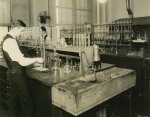 In my last post, I mentioned that the Government Printing Office (GPO) played an important role during World War II in preventing prisoners of war from using invisible inks to send intelligence back to the Axis powers. Here’s the story of that secret battle fought by the paper experts at GPO.
In my last post, I mentioned that the Government Printing Office (GPO) played an important role during World War II in preventing prisoners of war from using invisible inks to send intelligence back to the Axis powers. Here’s the story of that secret battle fought by the paper experts at GPO.
From late 1942 to mid-1946, the United States experienced an unprecedented influx of almost a half-million German, Italian, and Japanese prisoners of war. They were in a position to damage the war effort through attempts at escape and, based on prior experiences in World War I with German prisoners of war, the possibility of espionage.
Since the Geneva Convention mandated that prisoners of war could write home, significant information on prisoners’ locations and labor activities could be transmitted through the use of invisible or sympathetic inks made from such common substances as lemon juice, milk, washing soda, baking soda, starch solution, and even human urine. The Convention also severely limited the use of heat and chemicals to detect secret messages on such letters. The War Department turned to GPO’s chemists (see photo above) for an answer.
After extensive tests, GPO’s experts developed a paper base with a silicate or clay coating. The coating contained a powder or dyestuff that would react to moisture or any acid water solution by turning green. The paper was called Sensicoat. This paper’s heavy 56-pound weight, high cost, were negative factors, so GPO then developed a lighter, uncoated, and more economical paper, Analith. After this paper went into production, secret messages to the Axis were greatly reduced. It was a reduction noticed and acted upon by German intelligence.
American censors noticed something very interesting about packages of food and clothing addressed to German prisoners as 1944 passed the halfway mark. A small amount of putty-like material about size of a kitchen match head began to turn up in various places of concealment. Repeated tests showed that the putty-like material was a “dry ink.” After several conferences with the wartime Bureau of Censorship regarding this problem, GPO’s chemists began work on a new paper, bearing in mind that it also would have to retain its sensitivity to fluid invisible inks. The result was a coated sheet processed with a water-sensitive formula and with great sensitivity to the detection of all types of dry inks
By 1945, more than 29 million sheets of the new stationery had been ordered at $1.04 per thousand and GPO had blocked a potentially dangerous flow of information toAmerica’s enemies. It was an achievement shrouded in wartime secrecy, but one gratefully acknowledged by those who knew about the technical difficulties involved.
For more GPO history, go here.



 Posted by govbooktalk
Posted by govbooktalk 